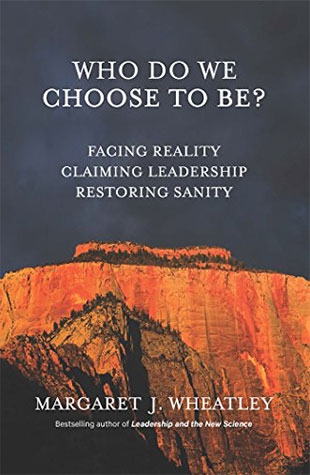Margaret Wheatley writes, teaches, and leads workshops around the globe. She is a wise woman who always asks the right questions. Who Do We Chose to Be? is her ninth book, and it is dedicated to the Buddhist teacher Pema Chödrön who with the gifts of insight and compassion "led me onto the path of warriorship and continues to guide me further." Wheatley now teaches this art in a one-year program at Schumacher College.
Summoning just the right mix of sober-mindedness and tenderness, the author explores the pattern of collapse of complex civilizations. America's chaos is already here with a culture that is caught up in consumerism, celebrities, scandals, and the omnipresence of war. The time is ripe for leaders whose charisma rests not in power plays and aggression but in the healing qualities of compassion, discernment, and presence.
Wheatley quotes another sagacious Buddhist, Chögyam Trungpa, who spells out the need to move beyond hiding or seeking a magical place of self-protection. "We cannot change the way the world is," he observes, "but by opening to the world as it is we may discover that gentleness, decency, and bravery are available, not only to us, but to all human beings." This is preferable to putting our confidence in social media, apps, artificial intelligence, or the latest technological toys.
At the heart of Who Do We Choose to Be? is an uplifting call for leaders who will be able to deal with the overwhelming problems of our times and work for the common good. Wheatley calls these individuals "Warriors for the Human Spirit" (see excerpt). In detail she lays out their missions: creating islands of sanity, guiding with courage and integrity, dealing with the impossible, directing social change, depending on diversity, inspiring with the joy of Interbeing, and standing for what is right.
Wheatley even leaves some space for humor when she writes: "It's hard not to notice the ubiquitous presence of smartphones and tablets now in every hand. I've imagined a visitor from outer space sculpting an image of the human body: one hand would be shaped as a small rectangular object."
One of the many appealing things about this paperback is that the design element comes across as both snappy and practical with large type for quotations, handy notes at the end of each chapter, and a writing style that embraces "the big picture" along with fascinating bits and pieces. An appendix, three pages of recommended readings, and a helpful index round out the book.
And just to keep us all on our toes, Wheatley concludes: "Now we have front row seats in the lessons of interconnectedness and the consequences of ignoring nature's fundamental truths. As the ecologists have noted: nature bats last."
